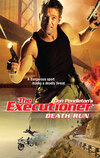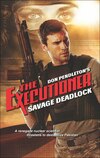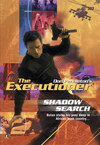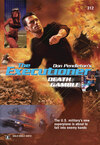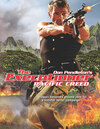Kitabı oku: «Defense Breach», sayfa 2
The snowmobiles appeared in his binoculars as six specks of light when they were still miles from the section where trees grew in shallow stands dotting the open prairie. Sherry said that Davey and Wes were able to give their killers only one-half of the code. Bolan thought amateurs might naively believe they were protected when dealing with terrorist elements by not turning over the complete package until they received full payment. But what an inexperienced person might not understand was a terrorist’s willingness to torture and steal rather than part with money that could be better spent on recruitment, weapons and training. They’d kill everyone involved simply to cover their tracks and eliminate all traces of their transactions. Bolan had witnessed the scenario too many times to count. In a transaction pitting rookies against professionals, the pros always won.
As he watched the approaching snowmobile headlights, he pondered the group’s return. Sherry had tried to make a call on her cell phone, not realizing that out here in the wilderness, the probability of being in range of a communications tower was slim. What she had actually done was send out an electronic ping that announced her presence while it searched for a connection. The killers had to have picked up the transmission on a scanner and realized that the third person they suspected could have been with Davey and Wes was, in fact, in the cabin. They were coming back to finish the job.
They were about to get more than they bargained for, the Executioner thought.
From his position at the base of a thick maple, Bolan reached into the pouch on his web belt containing his night-vision goggles. He focused the goggles, bringing the six pinpoints of light into sharp relief. Magnified hundreds of times as they passed through the internal photocathode tube, the photons from the approaching headlights shone with the intensity of search beacons. Each snowmobile carried a single rider, and it appeared that one vehicle was pulling a sled holding something that resembled a miniature howitzer. From its profile, Bolan was sure the item was a weapon of some type. Its pertinent characteristics, he knew, would soon become known. He drew his Beretta 93-R from its shoulder holster, reached into the pouch holding the handgun’s suppressor and screwed the extension onto the end of the pistol’s barrel. He knew there was going to be gunfire, and figured he should delay announcing his location until absolutely necessary.
The snowmobiles maintained a steady speed, splitting up when they came close. The vehicle pulling the sled with the unknown weapon halted approximately twenty yards from the cabin, while two veered off toward Bolan and the other three set out to circle the structure and cruise along the adjacent tree line from the opposite direction. The precision of their maneuver reinforced Bolan’s earlier consideration that they might be skilled combatants. He remained silent as the pair coming his way passed in front of his position, taking note of their weapons as they passed.
The men were armed with Uzi submachine guns slung across their chests on canvas slings. The fixed wooden stocks were characteristic of the very early versions of the famous weapon, but Bolan knew enough not to assume that the vintage models were anything less than lethal.
Through his night-vision goggles, Bolan studied the man with the sled weapon as he began preparing the contraption. At first glance it appeared to be a stubby cylinder mounted onto a rectangular metal box, but as Bolan continued to observe, he noted that the tube was not hollow, and thick cables ran the entire length of the protrusion. There was a sighting mechanism close to one end, and dual handles similar to those found on antiaircraft guns. The operator fiddled with what had to have been dials or switches on his side of the box before grasping the dual handles and maneuvering the tube. The comparison to an antiaircraft gun was further reinforced with the cylinder being mounted on a free-floating ball pedestal affording the gunner complete three-axis rotation.
The two men who had passed Bolan continued on their slow route circling the cabin. They were halfway between Bolan and Sherry’s hiding place when she abruptly burst from under the pine, hysterically begging them not to kill her. As they hastily grabbed to pull their Uzis into firing position, Bolan’s silenced 93-R coughed twice in such rapid succession the rounds sounded as if they shared a single retort.
The first 9 mm Parabellum round struck the driver of the snowmobile on Bolan’s right, entering the base of his neck on an upward trajectory. The hot lead tore through his skull, exiting from the center of his forehead and splattering most of his frontal lobes onto the machine’s dashboard controls. The tissue immediately froze upon contact with cold metal that had been exposed to frigid air for hours. The man’s throttle hand froze in a death grip, causing his snowmobile to surge forward, accelerating him directly into the side of the building where the machine crashed and revved angrily while the spinning tread underneath chewed and spit out a thin stream of snow for a few seconds before stalling.
His partner fared no better. Bolan’s second bullet slammed a millisecond after the first into the middle of his back, piercing his heart and shattering his sternum on its way out. The gaping chest wound left in the slug’s wake was immediately filled with a scarlet fountain rushing forth in a torrent of steaming blood that painted a thick swath across the ground. He slumped forward, bounced off the steering wheel and fell sideways into the snow. His vehicle came to an abrupt stop a few feet from the lifeless body.
The mind-numbing chatter of automatic fire filled the air as the three who had circled the cabin from the other direction opened fire on Sherry. The 9 mm steel-jacketed rounds sliced diagonally from her left knee to her right shoulder, causing the young woman to jerk and dance wildly. A burst into her upper torso lifted her off her feet and hammered her backward into the woods, where she landed faceup, unseeing eyes staring into the star-studded sky.
Realizing they were under attack, the gunmen immediately shifted their fire away from the dead woman and began hosing the woods with a steady stream of lethal lead. Not being sure of Bolan’s position, they swept their weapons in wide overlapping arcs, reducing branches and saplings to a blizzard of matchsticks that rained down onto their intended victim’s head.
With their wild response telling him that his enemies had not yet zeroed in on his position, Bolan remained prone while pulling the Desert Eagle off his hip.
An electronic humming, so low it sounded almost like an earthquake’s rumbling, emanated from the sled weapon. The operator shouted out a warning to his companions seconds before the hum increased in both intensity and pitch. The entire cabin began to vibrate. Thin tendrils of smoke rose from the weathered siding like surface fog rolling across a body of water, then the cabin abruptly burst into flame. An instant later, the propane tank exploded in a fireball reaching two hundred feet into the sky.
Microwave, Bolan thought, immediately elevating the weapon’s operator to the top of his hit list. Unaware that his cohorts on the other side of the cabin were under attack, the gunner leaned forward over a control panel to make an adjustment, exposing the upper half of his body. With the noise from the crackling fire racing through the wooden structure masking his Desert Eagle’s authoritative discharge, Bolan squeezed off a single round while remaining concealed behind the base of the thick maple. The pistol’s hefty .44-caliber slug caught the microwave gunner square in his chest, tossing him airborne for a few seconds. He bounced once upon hitting the frozen ground, landing on his back with arms extended to the sides.
The Executioner directed his fire toward one of the remaining three who was visible beyond the burning cabin. Pulling the trigger as rapidly as he could, he released a stream of bullets, forcing the gunman within his line of sight to dive off his snowmobile and take cover behind the vehicle. Bolan’s rounds sparked and whined as they impacted the snowmobile’s metal fuselage, adding to the visual and auditory chaos of combat.
Displaying a telling level of advanced training, the gunmen fanned out in an attempt to separate sufficiently to establish a triangular focus on Bolan’s position, which was now fully exposed by the Desert Eagle’s prolonged volley. While the two who were still mounted on snowmobiles moved away, the man on the ground covered their progress with his Uzi on full-auto, filling the air around Bolan with deadly shot.
The warrior had seen the maneuver countless times. If he stayed put, his enemies would flank his position and kill him in a cross fire. He remained low while edging away from the tree trunk, waiting for a break when the gunman would be changing magazines. As if his enemy was enacting his mental script, there was a momentary tapering off in the covering fire, and Bolan seized the opportunity to dash in a crouch into the thin woods to the spot ten yards away where he had stashed his snowmobile. As he ran, he ejected the spent magazine in his Desert Eagle, grabbed into his ammo pouch for a fresh one and rammed it home.
Behind him, the cabin groaned once and collapsed on itself with a heavy sigh resembling a man’s final exhale, becoming a fifteen-foot heap of flickering rubble. Without the building’s hungry flames leaping high into the air, visibility was abruptly and dramatically reduced.
Peering through the trees with his night-vision goggles, Bolan could see his adversary in a prone position behind his snowmobile, the stubby muzzle of his Uzi poking around the vehicle’s front end. The man’s partners had moved far enough away to be outside the halo emitted by the burning cabin, apparently playing the odds that their opponent would not be equipped with night vision. Considering what his course of action would be if the tables were turned, Bolan thought his enemies would take cover in one of the little snow gullies before attempting a flanking movement. He jumped onto his snowmobile, revved the powerful motor, and sped straight toward the gunman who had been attempting to pin him down while his partners maneuvered.
In an effort to reduce his profile as much as possible, Bolan hugged his snowmobile’s fuselage as he shot out of the tree line on a direct course for the man lying in a covered position behind his vehicle. Making sure to maintain a straight-on approach to take advantage of the protection his snowmobile’s windshield offered, Bolan fired the Desert Eagle with his left hand, holding the snowmobile’s handlebars steady with his right.
The move obviously surprised his opponent, who hesitated for a fatal second before engaging the fast-approaching warrior with his Uzi, filling the night air with the chilling sound of automatic chatter. The 9 mm lead sprayed wildly across the space separating Bolan from his enemy. Bullets ricocheted off his bulletproof windshield as he charged forward at full throttle, covering the distance between him and his foe in less than thirty seconds. In a move resembling that of a bullfighter, the Executioner swung outward at the last instant in order to avoid a collision, his Desert Eagle roaring death in triple-time tempo. A few rounds sparked upon impact with the gunman’s Uzi a nanosecond before a pair of .44 rounds whizzing through the air in heel-to-toe configuration found the man’s face, exploding his head in a crimson blossom. Bolan pulled hard on the snowmobile’s handlebars while depressing the brake, causing the machine to slide sideways next to the dead man’s vehicle. Throwing himself to the ground, he rolled into a prone position taking advantage of both snowmobiles for cover.
From his new location, he looked out beyond the pile of smoldering rubble of the cabin. One of his two remaining opponents was crawling toward the microwave cannon, while his partner engaged Bolan with a steady stream of lead from the relative safety of a snow gully approximately fifty feet away. Bolan drew his Beretta and fired the silenced weapon with his right hand while simultaneously blazing away with the Desert Eagle in his left, halting the man’s progress toward the cannon and driving him back into the same gully as his teammate. A series of angry curses told him he had hit, albeit not fatally, the gunner trying to reach the microwave weapon.
With his enemies now occupying positions where they could battle him with only their heads exposed above the lip of the gully, the situation was classic trench warfare. Two adversarial forces separated by a no-man’s land one hundred yards wide, with the microwave cannon occupying a position equidistant from both sides. In this situation, the day would belong to the combatant who could flush the other from cover.
Bolan holstered his Beretta, changed out magazines in the Desert Eagle and, while sporadically firing well-aimed shots to prevent his foes from advancing, reached into one of the pouches on his web belt containing a length of thin cord resembling braided dental floss. The three-hundred-foot length of specialty twine was fine enough to fold entirely in the palm of his hand while possessing all the strength of mountaineering rope.
Remaining behind the fuselage of his late adversary’s snowmobile, Bolan reached up and wrapped a section of the cord around the vehicle’s throttle to provide a steady fuel supply. When he turned the ignition key, the engine sprang to life, purring in neutral while he twisted the handlebars to aim the snowmobile toward the gully holding his foes. With the rounds from his Desert Eagle keeping his opponents pinned, Bolan used his free hand to unhook two concussion grenades from his combat belt’s webbing and set the fuses to their maximum thirty seconds. Throwing the shift into gear, he dropped the apple-shaped bombs into the snowmobile’s two cup holders and released the vehicle.
The snowmobile moved on a perfectly straight course from Bolan to the gully, where it toppled into the depression, carrying its lethal load into the trench occupied by the two gunmen. When the grenades detonated with an eardrum-throbbing concussion, they ignited the vehicle’s gas tank, spraying the fuel through the trench in a firestorm reminiscent of a Vietnam napalm attack. The ferocious explosion left no doubt regarding its effectiveness, but Bolan had his Desert Eagle loaded, cocked and held at the ready when he walked to the edge of the snow gully to investigate the damage. His former adversaries were charred beyond recognition, calling to mind the corpse he had discovered inside the cabin.
The Executioner walked slowly back to his snowmobile, started the engine and drove to the microwave weapon. With a remaining section of the cord, he was able to securely attach the sled to his vehicle before setting off toward the North Dakota border approximately seven hours distant. When he got close to the States, he’d come into range of a telephone tower enabling him to make an encrypted call to Barbara Price, Stony Man Farm’s mission controller. She would take care of the necessary cleanup and the retrieval of remains to be delivered to the families of the Nautech engineers.
The hunting horn had been sounded. There were miles to go before the Executioner would find rest.
2
Ali Ansari Hasseim squinted against the water’s glare as he gazed southwest from the outskirts of Bandar-e Abbas, a biblical town on Iran’s Persian coast across the channel from Qeshm Island. Below him sat the narrow Strait of Hormuz, through which twenty percent of the world’s oil supply passed. The busy waterway was bordered by Iran, Oman’s Musandam Peninsula and the United Arab Emirates. Were it not for the region’s constant political unrest, the Iranian shoreline’s rugged beauty and perfect climate would have the potential to make the locale one of the world’s top vacation destinations. As it was, however, there were no vacationers in the vicinity. Most of those who ventured along the scenic trails traversed by Hasseim and his ilk were heavily armed with the intent to kill.
For centuries, the coastal strip on which Hasseim and his four companions stood had been recognized as a strategic key to controlling the entire Persian Gulf. Blocking the landlocked waterway’s sole egress at the point where it emptied into the Indian Ocean’s Gulf of Oman was a tactic used at a time when the only power available for ships came from either the wind or human rowers. In contemporary times, closing the Strait of Hormuz would create a logjam, snarling military and commercial traffic alike. In such a situation, American warships patrolling the Gulf would be sitting ducks.
Wind gusts hugging the shoreline whipped a combination of sea salt and desert dust into thin clouds that raced across the land break. Hasseim avoided breathing the gritty mixture by pulling a corner of his black checkered kaffiyeh over his nose and mouth, covering the jagged scar that ran from his left earlobe to the edge of his lower lip, tugging his mouth into a perpetual frown.
In the distance, silhouetted against the horizon out beyond the islands of Hormoz and Larak, Hasseim could see the USS Dwight D. Eisenhower, one of the United States Navy’s nuclear aircraft carriers. At the sight of the occupying force, Hassein’s heartbeat quickened in anger. Bitter bile found its way into his mouth, causing him to turn from his companions while he lifted the corner of his kaffiyeh and spit the rancid liquid onto the ground where it was immediately absorbed into the dust.
His network of spies kept Hasseim informed as to the location of the other CVN-class ship in the region, enabling him to redirect missile deployments when necessary. The militia commander was fully aware that when the time arrived to punish the infidels for invading and occupying sacred soil, the window of opportunity would be short-lived. For a missile attack on multiple targets to be successfully coordinated, prior placement of troops and equipment was absolutely critical.
As he waited for his captives to be delivered, Hasseim mentally inventoried his militia’s missile stocks. In the area around Bandar-e Lengeh at the mouth of the strait, trusted fighters possessed more than four hundred American-made FIM-92A Stinger missiles. The shoulder-launched weapons had been among tens of thousands provided by the CIA in 1979 to mujahideen guerrillas engaged in their nine-year war against the Soviets in Afghanistan. Two decades later, when Western forces responding to the 9/11 attacks toppled the country’s Taliban government, they attempted to round up and confiscate an estimated thirty thousand residual Stingers. But in a swiftly deteriorating country where there were more pressing priorities for the NATO troops than disarming regional warlords, a hastily conducted campaign yielded less than six thousand missiles. The remainder were quickly reallocated throughout the Middle East to Islamic militias such as Hasseim’s. With the ability to deliver a 2.2-pound high-explosive warhead at supersonic Mach 2 speed from a range of up to five miles, the thirty-five-pound highly portable Stingers were major assets for any militant organization.
In addition to the Stingers, Hasseim also had access to six hundred Soviet SA-7 Grail missiles that had been sold indiscriminately to anyone willing to meet the asking price when the Communist empire collapsed. Although Grails were considerably less accurate than the heat-seeking Stingers, they possessed a range of almost four miles and, in quantity, could overcome their accuracy deficiency and contribute significantly to overall success.
All told, Hasseim held the means to attack the two United States aircraft carriers patrolling the channel’s narrow passageway at Hormuz with more than one thousand missiles. Troops to the southeast in Sirik would join fighters positioned in Bandar-e Lengeh at the mouth of the strait and across the waterway in Al Khasab to completely surround backlogged targets. Hundreds of missiles guided by infrared seekers would come raining down from all sides onto the enemy’s warships, delivering a stunning statement about the technological capabilities possessed by local Islamic militias. While certainly not on par with the glorious 9/11 attacks conducted on the barbarians’ own soil, Hasseim believed his offensive could be a decisive blow toward ending American occupation of the region. The only hurdle remaining was a computer system onboard American carriers that automatically shielded the vessels while engaging incoming targets. Hasseim now possessed one-half of a program that could disarm the protective system. If all went according to plan, he’d have the other half very soon.
At the moment, his activities were intended to misdirect the Americans. Hasseim didn’t know if his plans would be discovered prior to launching an attack, but if they were, he wanted to make sure the Americans were searching in the wrong direction until he had the time he needed.
The four men accompanying their field commander were dressed in dark pants and brown shirts with long sleeves. On their feet they wore canvas combat boots, and each carried P-90 submachine guns.
The men also wore black checkered head scarves, identical to the kaffiyeh worn by their leader. Hasseim’s army was one hundred percent Shiite, and in addition to their primary objective of driving the occupying infidels from their holy land, each member had also taken a solemn oath to eradicate the Sunni population responsible for polluting Islam.
A sudden movement in the distance caught Hasseim’s eye. A battered white panel truck was speeding their way, trailing in its wake a yellow dust cloud reaching ten feet into the air. Hasseim nodded to his companions, who walked away from their SUV in order to put a buffer of safe distance between themselves. As they moved, they brought their P-90s to the ready position.
The truck bounced over the dusty coastal trail at breakneck speed, coming to a skidding halt ten feet from where Hasseim stood. The front doors flew open, and two men jumped out and hustled to the commander.
“Allah be praised,” the first said breathlessly, “your servants have been blessed with success.”
“You have them all?” Hasseim asked in a flat voice.
“Yes,” the driver replied as he and his companion began moving toward the back of the truck. Hasseim followed a few steps behind, his P-90 loaded and cocked. His right index finger itched with anticipation as it rested on the weapon’s trigger.
When they reached the vehicle’s rear, the driver unlocked the back door and threw it open. On the floor inside, five men lay with their feet tied and their hands bound behind their backs with heavy nylon wrist wraps. Burlap bags covered their heads, loosely cinched at the throat with black shoelaces. Three were wearing United States Army uniforms, the unit patch on their left shoulders bearing the numeral one embroidered in red thread. They were members of The Big Red One—the Army’s First Infantry Division.
Hasseim’s lips curled into a cruel smile when he saw his quarry.
“The others?” he asked, indicating the two in civilian dress with the barrel of his P-90 submachine gun.
“Munjian,” the driver responded, referring to a secondary Sunni militia operating along the Iraqi border.
Hasseim signaled to the men who had come with him, and they trotted to his side. He motioned toward the captives with his chin, and two bent into the truck, grabbed a soldier by the uniform and dragged him to the floor’s edge. Upon being moved, the trussed man began jerking against his restraints, repeatedly arching his back until Hasseim took a step forward and gave the burlap bag covering the man’s head a sharp rap with the butt of his submachine gun. The soldier stiffened at the blow and stopped squirming.
Once the bound prisoner was still, one of Hasseim’s men gripped him under the armpits while another grabbed him around his knees. Grunting under the effort, they lifted the trussed American and hefted him clear of the truck’s cargo hold, making space for their two teammates to duplicate their action with a second soldier. The truck’s driver and his companion followed suit when the second team moved away, pulling the final soldier from the back of the truck. Staggering slightly, they followed the others, carrying their soldier from the vehicle toward a spot designated by Hasseim roughly twenty yards away. There the soldiers were thrown onto the ground to await their fate. Although they remained motionless, their raspy breathing could be heard through the burlap sacks covering their heads, as rapid and shallow as a trapped rabbit’s.
“Move them apart,” Hasseim ordered as he slung his P-90 over his shoulder. While his men obeyed his order, he walked to the panel truck’s open passenger door, reached into the leg space in front of the seat and came out holding an Uru Model II submachine gun. The stockless 9 mm Brazilian assault rifle had a well-earned reputation for fouling when exposed to the slightest amount of moisture or dust in the chamber. Despite its notorious unreliability, the inexpensive weapon with its 30-round magazines was a favorite among Third World militias. The Sunni Munjian was known to have outfitted their members with Urus.
Hasseim rammed the rifle’s slide to the rear and let it fly forward, chambering the first of the thirty slugs waiting inside the clip. After scanning the area with dispassionate eyes to make sure his men were clear, he pulled the weapon into his shoulder and, leaning forward slightly, opened fire on the trussed soldiers laying on the ground.
The Uru spit death on full-auto, filling the air with mind-panicking chatter. Hasseim swept the gun from left to right and back again, hosing the men from head to toe with lethal lead. The 9 mm slugs tore the corpses to pieces, slamming through flesh and bone before exiting through gaping holes the size of tennis balls. The Uru’s firing pin finally clicked onto an open chamber, and the weapon fell silent.
Hasseim’s eyes were glassy, his face flushed. He placed the Uru on the ground at his feet and turned to the truck’s passenger seat. This time, he brought an American M-16 from the front leg well.
The two Sunni militiamen were chanting death prayers when they were pulled from the back of the truck to a spot thirty yards from the soldiers’ corpses. There they were unceremoniously dumped onto the ground, and Hasseim reenacted his prior murderous action, spraying the captives with M-16 rounds.
When the magazine was exhausted, he lowered the rifle, his ears ringing from the auditory assault of the M-16’s automatic barrage. His rapid breathing irritated the inside of his nostrils with the stench of death and cordite that now hung heavy in the late afternoon humidity. As his men rushed forward to cut the bonds from the dead men, he took a few steps back, handing the empty M-16 to one of his assistants. When Hasseim’s men finished arranging the bodies, it would appear all had died in a firefight. Skirmishes between independent militia and NATO forces were an everyday occurrence in this region; there would be no reason for anyone to doubt the evidence.
“Abbas,” Hasseim called out, bringing a thin young man with alert brown eyes to his side. “Give this to one of them,” he said softly, holding out an eight-gigabyte memory stick wrapped tightly in a plastic sandwich bag.
Abbas took the memory stick and hustled to the side of the Sunni on the left as Hasseim began walking to his SUV. Only he and his driver would take the trip back, the others would remain to arrange the scene.
“The Americans will be alerted?” Hasseim asked the driver, although his tone conveyed the question was more a statement than an inquiry.
“Within hours. We’ll give them GPS coordinates. They’ll be here tonight,” the driver replied.
Hasseim took a final look toward the water when they reached their vehicle. The sun was low, reflecting off the Gulf’s rippled surface. In his mind, he pictured the narrow channel jammed with American warships. From the highlands above the strait, militiamen equipped with hundreds of missiles would find the unprotected vessels easy targets. Allah be willing, the remainder of the code would be delivered to his servants and the infidels would be destroyed.
Running a dry tongue over his chapped lips, Hasseim climbed into his SUV. For the first time since morning, he thought of his most recent partners in Las Vegas, the city that in Hasseim’s mind, said all there was to say about Western civilization.
Ücretsiz ön izlemeyi tamamladınız.

